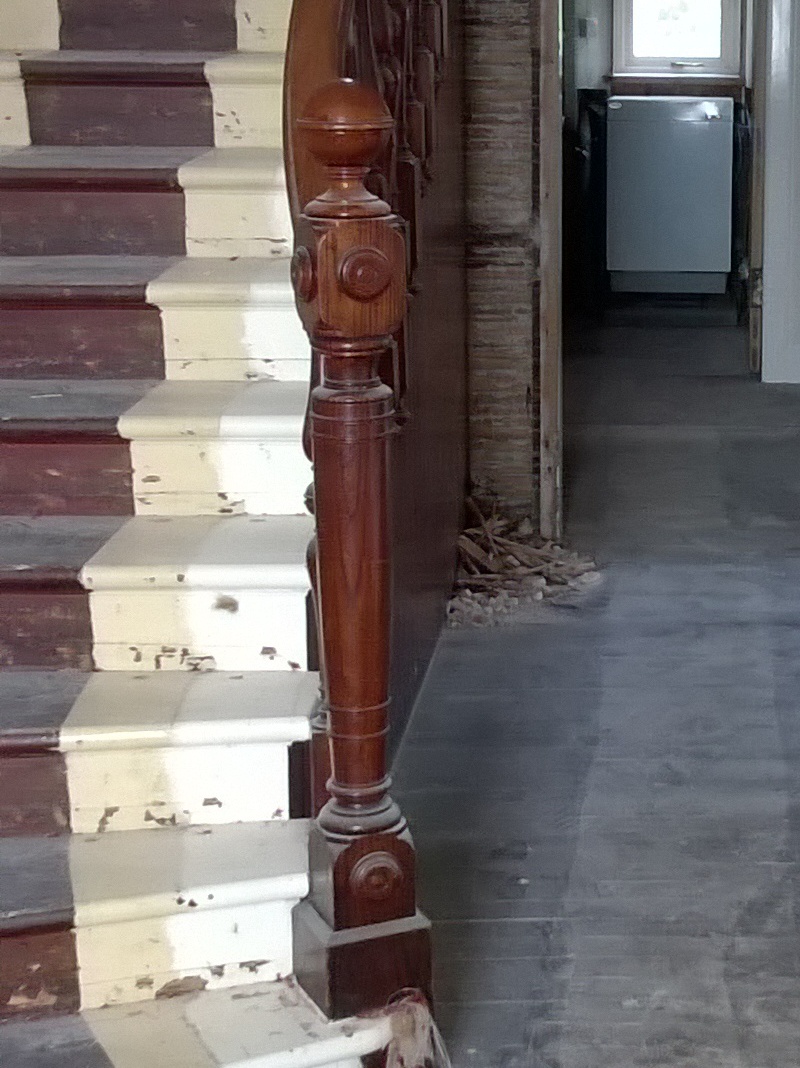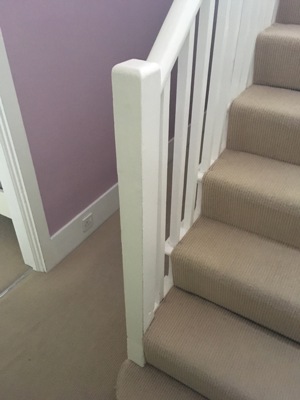Newel post
Stairs are used to create a pedestrian route between different vertical levels by dividing the height between the levels into manageable steps.
Stairs, in particular in domestic premises, may include guarding to one, or both sides, in the form of a banister, that is, an assembly of uprights and a handrail.
The main upright supporting the handrail, is known as the ‘newel post’. These are typically found at the bottom of stairs, but can also be found at the top, and in intermediate positions, such as landings.
Newel posts can be simple, or can be very ornate. Ornate newel posts may sit on a newel base, and be capped by a spherical finial. They can be solid or hollow constructions.

|

|
| Ornate newel post with finial. | Simple newel post. |
In medieval times, the newel (Old English: Noel, Nowel and Nuel) was the central column around which a spiral or circular staircase wound. In some parts of Northern England, the newel column would terminate above the uppermost level of steps and continue up to a vaulted roof where ribs would radiate from it, giving a palm-tree effect, as at Belsay Castle, Northumberland (14th century).
[edit] Related articles on Designing Buildings Wiki
- Approved Document K.
- Banister.
- Finial.
- Guarding.
- Lifts.
- Poppyhead.
- Railing.
- Ramps.
- Stairs.
- Stairs going.
- Stairs nosing.
- Stairs riser.
- Stairs tread.
Featured articles and news
Latest Build UK Building Safety Regime explainer published
Key elements in one short, now updated document.
UKGBC launch the UK Climate Resilience Roadmap
First guidance of its kind on direct climate impacts for the built environment and how it can adapt.
CLC Health, Safety and Wellbeing Strategy 2025
Launched by the Minister for Industry to look at fatalities on site, improving mental health and other issues.
One of the most impressive Victorian architects. Book review.
Common Assessment Standard now with building safety
New CAS update now includes mandatory building safety questions.
RTPI leader to become new CIOB Chief Executive Officer
Dr Victoria Hills MRTPI, FICE to take over after Caroline Gumble’s departure.
Social and affordable housing, a long term plan for delivery
The “Delivering a Decade of Renewal for Social and Affordable Housing” strategy sets out future path.
A change to adoptive architecture
Effects of global weather warming on architectural detailing, material choice and human interaction.
The proposed publicly owned and backed subsidiary of Homes England, to facilitate new homes.
How big is the problem and what can we do to mitigate the effects?
Overheating guidance and tools for building designers
A number of cool guides to help with the heat.
The UK's Modern Industrial Strategy: A 10 year plan
Previous consultation criticism, current key elements and general support with some persisting reservations.
Building Safety Regulator reforms
New roles, new staff and a new fast track service pave the way for a single construction regulator.
Architectural Technologist CPDs and Communications
CIAT CPD… and how you can do it!
Cooling centres and cool spaces
Managing extreme heat in cities by directing the public to places for heat stress relief and water sources.
Winter gardens: A brief history and warm variations
Extending the season with glass in different forms and terms.
Restoring Great Yarmouth's Winter Gardens
Transforming one of the least sustainable constructions imaginable.






















